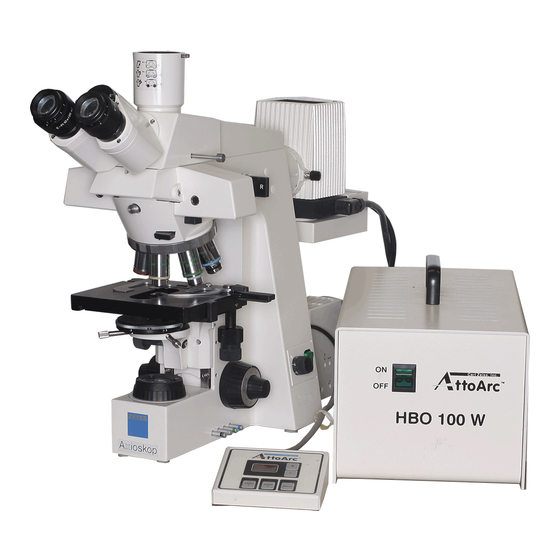
Advertisement
Quick Links
Download this manual
See also:
Operating Manual
ZEISS AXIOSKOP
Microscope's User Manual
Managed by
For information about this instrument, please contact
Dr. Alloysius Budi Utama @ ext. 8232 or e-mail
budiutama@rice.edu
Advertisement

Summary of Contents for Zeiss AXIOSKOP
- Page 1 ZEISS AXIOSKOP Microscope’s User Manual Managed by For information about this instrument, please contact Dr. Alloysius Budi Utama @ ext. 8232 or e-mail budiutama@rice.edu...
- Page 2 Use of the Axioskop (Zeiss) The Axioskop is equipped for viewing samples with transmitted light (from a halogen lamp source) and has optics for: Bright field, Phase Contrast and Differential Interference Contrast (DIC) microscopy. Samples can also be viewed for fluorescence microscopy using the incident- light system (front a mercury lamp source).
- Page 3 position. Obtain a "basic" focus using the coarse (large inner black knob), and then if desired, the fine (smaller outer knob) coaxial focusing control knobs (on the back left and right side of the microscope base). *Note: one revolution of the course knob = ~2 mm of stage travel toward any Z-direction Kohler Alignment To achieve maximum even illumination of the sample, the condenser needs to be properly focused and adjusted (Kohler Alignment)
- Page 4 Raise /lower the condenser apparatus by turning the small black knob (3c - on the left back side of the condenser below the stage) until the circumference of the light image is "sharp and well defined as a hexagon shape." Sharp edge Before After...
- Page 5 The best DIC images are determined empirically, and important factors are: positions of the prism (adjusted by turning the little silver screw above each objective lens – red arrows in left image) and the condenser aperture diaphragm. Turn the prism screw for the desired image, and turn the diaphragm ring –...
- Page 6 When the arc lamp is turned on, and the slide/specimen is placed in position on the stage, illumination of the sample from the objective lens will be readily apparent. The slider, black and marked L on left side and R on right side, can be used to block / interrupt the illumination beam path (move to far right position) when not viewing the sample to prevent photobleaching.
- Page 7 Zeiss Axioskop Fluorescence Reflector Slider The first (right-most) position: (for FITC/ AF488/ GFP - type fluorophores) Excitation filter: 450 - 490 nm Dichroic mirror: 495 nm Emission filter: 500 - 550 nm Second position: (for Rhodamine/ AF594/ Texas red - type fluorophores)
- Page 8 Objectives for Zeiss Axioskop Plan - NEOFLUAR 10X, NA 03 Ph 1 (air; n=1) Phase contrast: condenser position 1 Brightfield: condenser position HDIC DIC - contrast: condenser position DIC Plan - NEOFLUAR 20X, NA 0.5 Ph 2 (air; n=1) Phase contrast: condenser position 2...













